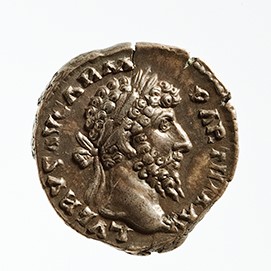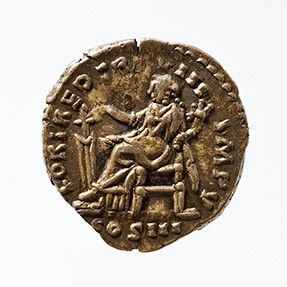Acquisition number: 1972.09
Obv.: Head of Verus r., laureate, bearded; hair in tight curls. L(ucius) VERVS AVG(ustus) ARM(eniacus) PARTH(icus) MAX(imus).
Rev.: Fortuna seated l., draped, holding rudder in right hand and cornucopiae in left. FORT(una) RED(ux) TR(ibunicia) P(otestate) VIII IMP(erator) V. In exergue, COS III.
Title: Denarius of Lucius Verus - 1972.09
Acquisition number: 1972.09
Author or editor: Beryl Rawson
Culture or period: Roman Imperial
Date: AD 168 (Feb.-Dec.)
Material: Metal - Silver
Object type: Coins - Roman
Dimensions: 18mm (w)
Origin region or location: Italy
Origin city: Rome
Display case or on loan: 7
Keywords: Coin, denarius, Roman, Imperial, Lucius Verus, Fortuna
Sear, D.R., Roman Coins and their Values 5 vols (London, Spink, 2000-2014) 5350; Seaby, H.A., Roman Silver Coins (London, B.A. Seaby, 1967) 111; Mattingly, H.,Coins of the Roman Empire in the British Museum, 6 vols (London, 1965) 477 pl.62.5; Mattingly, H., E.A. Sydenham, C.H. Sutherland, R.A. Carson, The Roman Imperial Coinage 13 vols (London, Spink, 1923-1994) III 261 no. 586; See. Robertson, A. Roman Imperial Coins in the Hunter Coin Cabinet, University of Glasgow 5 vols (Oxford: Oxford University Press, 1962-1982) II pl.103.43; Breglia, L., Roman Imperial Coins: Their Art and Technique (New York, F.A. Praeger, 1968) 156-159.
1972.09
Denarius of Lucius Verus
3.272 g. AD 168 (Feb.-Dec.)
Obv.: Head of Verus r., laureate, bearded; hair in tight curls. L(ucius) VERVS AVG(ustus) ARM(eniacus) PARTH(icus) MAX(imus).
Rev.: Fortuna seated l., draped, holding rudder in right hand and cornucopiae in left. FORT(una) RED(ux) TR(ibunicia) P(otestate) VIII IMP(erator) V. In exergue, COS III.
Verus became Augustus with Marcus Aurelius and received tribunician power in AD 161, on the death of Antoninus Pius. The eighth conferment of tribunician power was thus in AD 168. He had held the consulship once before Antoninus’ death, again in AD 161, and for a third time in 167. The infrequency of his consulships thus makes them a poor indication of date.
He received the titles Armeniacus and Parthicus Maximus during his Eastern campaigns (AD 163 and 165 respectively). The kingdom of Armenia was often a bone of contention between Rome and Parthia. In AD 161 the Parthian king had invaded Armenia and raided Roman territory in the East. In AD 162 Verus led an army East but took no part in the actual fighting. While he enjoyed the pleasures of the cities, his generals recovered Armenia (thus titles ARMENIACVS and IMP. II to Verus, as commander-in-chief) and moved on to victories in Parthia and other Eastern areas (thus PARTHICVS MAXIMVS and IMP. III to Verus). These successes kept Parthia quiet for some time. Verus returned to Rome in AD 166, as IMP. IIII, for a joint triumph with Marcus Aurelius. (Marcus had received all the same titles as Lucius, as joint commander, but dropped the Armenian and Parthian titles after Verus’ death.)
In AD 167, in spite of the drain of the recent Parthian War and the effects of the plague, an expedition to Germany and the Danube was being prepared to deal with the continued pressure on the northern frontier. Both emperors set out at the beginning of AD 168 and some early victory was celebrated by their being hailed imperator: this was the fifth such occasion for each of them, thus ‘IMP. V’. A settlement was made in the autumn of AD 168, but it proved not to be lasting.
This reverse appeared on both silver and gold coins of both Lucius and Marcus at this time. It celebrated their imminent return from the northern campaign. Lucius died on this return journey, in January AD 169. FORTVNA REDVX (‘Fortune the Bringer-home’) was often associated with emperors’ departures (as a wish for the future) or returns (as celebration). It had appeared on Verus’ coins in AD 162, when he set out for the East. It appeared again on the coinage of Marcus Aurelius and his son Commodus in AD 176, when they set out to deal with Eastern affairs in the wake of Avidius Cassius’ rebellion. Cf. 1965.07.
This portrait shows that Roman artists in the second century could still produce excellent work.
Sear, D.R., Roman Coins and their Values 5 vols (London, Spink, 2000-2014) 5350; Seaby, H.A., Roman Silver Coins (London, B.A. Seaby, 1967) 111; Mattingly, H.,Coins of the Roman Empire in the British Museum, 6 vols (London, 1965) 477 pl.62.5; Mattingly, H., E.A. Sydenham, C.H. Sutherland, R.A. Carson, The Roman Imperial Coinage 13 vols (London, Spink, 1923-1994) III 261 no. 586; See. Robertson, A. Roman Imperial Coins in the Hunter Coin Cabinet, University of Glasgow 5 vols (Oxford: Oxford University Press, 1962-1982) II pl.103.43; Breglia, L., Roman Imperial Coins: Their Art and Technique (New York, F.A. Praeger, 1968) 156-159.

